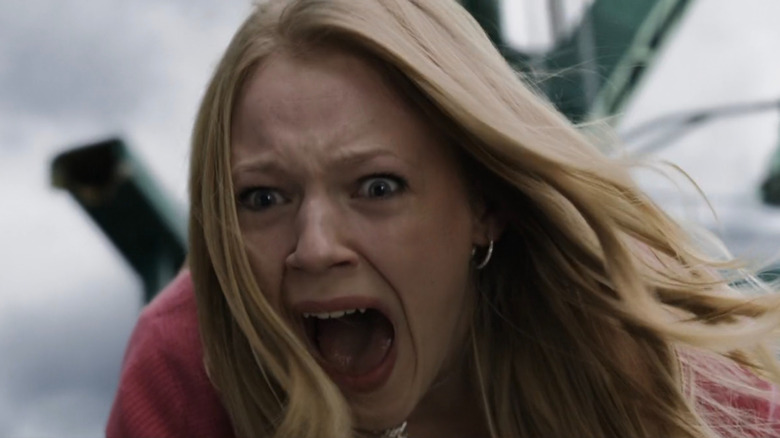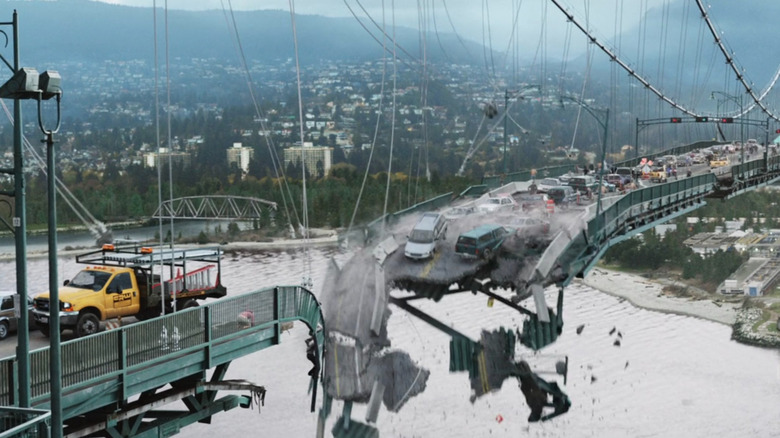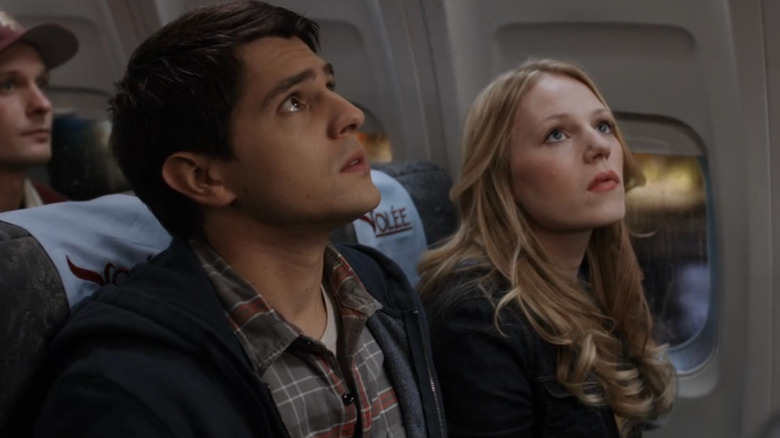Final Destination 5 Has The Best (And Most Compelling) Death Sequence In Any Horror Movie Sequel
This article contains spoilers for the first five "Final Destination" movies.
A good hook in a horror sequel can lure audiences in with the promise of a shakeup to the formula, whether it be adding a supernatural twist, ramping up the gore effects, or adopting a different tone altogether. You don't want a cool idea to get stale. One of the greatest strengths of "Final Destination" as a franchise is that each new film has mostly been able to sell itself by demolishing the sanctity of our everyday routines. James Wong, Glen Morgan and Jeffrey Reddick redefined the fear of flying for an entire generation. The series has since made it its mission to cast doubt over the little things — and the many ways they can kill us.
This is why "Final Destination" has maintained its cultural stronghold over the past 25 years, despite the last installment coming out nearly a decade and a half ago. I don't know a single person who doesn't immediately change to another lane when they discover that they're stuck behind a log truck in traffic because of "Final Destination 2."
Unlike other slashers where the central threat is an entity you can see running towards you, Death is an omniscient force that can take just about any form it wishes in order to collect another soul. In the midst of conjuring nightmares about getting on a plane, driving on the highway, and going on a roller coaster, the "Final Destination" franchise keeps evolving in interesting ways. Every subsequent installment is a response to the last, with some leaning further into comedy than others. By the time we reached 2009's "The Final Destination," however, the series had devolved into a dreadful parody of itself. It's telling that "Final Destination" is a series in which I'd understand any one of them being someone's favorite except for this ugly 3D eyesore.
"Final Destination" works best when there's some tangible element of fear that you can't quite shake, with an undercurrent of cheeky dark humor embedded with the Rube Goldberg-inspired bloodshed. Imagine my surprise when "Final Destination 5" not only turned out to be the best film in the series, but one of the greatest horror sequels ever made. And it all starts with the most intense premonition sequence of them all.
The harrowing bridge collapse sequence takes full advantage of the Final Destination formula
The people making a "Final Destination" movie know a large part of their audience is there to satisfy their curious bloodlust about all of the bizarre ways you can die. The opening premonition sequences are a perfect vehicle to give them a taste, but the bridge collapse that kicks off "Final Destination 5" is almost a full-course horror meal in and of itself.
The employees of Presage Paper are set to go off on a retreat, but as Sam (Nicholas D'Agosto) nears the bridge, he can't shake this feeling that something is terribly wrong. The high winds and unsightly construction wield a sense of unease in the air. Unlike most of these premonitions, where the clairvoyant is often resigned to the sequence set in motion, once the North Bay Bridge starts to crumble, Sam hops into action by getting as many people off the bus as he can. It's a full-blown action sequence that would feel right at home in a disaster movie.
As expected, the supporting cast get picked off in subsequent grisly fashion via hot tar, loose cable suspension wires, rebar wire and a whole car to the face, among others. In true "Final Destination" fashion, the film takes a sick glee in drawing out suspense for a sequence that only has one conclusion. The pre-disaster sequence endears us to this ensemble (except for Isaac because he sucks). For the first time, however, one person, Molly (Emma Bell), actually makes it out of harm's way in time, giving the impression that a few others could too. Sam works hard, but Death works harder.
Unlike "The Final Destination," director Steven Quale puts the 3D technology to good use here. The film was actually shot in 3D, therefore giving the effects an eye-popping sensation that I vividly remember making me flinch in my seat. The sequence is based on the Tacoma Narrows Bridge collapse of 1940 and if you've seen the unbelievable footage of it, you'll immediately know why it made perfect sense as an inciting incident. One of the film's most impressive visuals is this harrowing long shot after Sam narrowly hops onto the dangling piece of railing, as the bridge starts coming apart at the seams in rapid fashion. Quale holds on the destruction as the soundscape is suffused with countless screams as people are violently tossed into the water below.
Most "Final Destination" openings have their strengths, but this is an excellent technical feat that's the one to beat. How fitting that it would be followed up with an all-timer horror ending that brings the series full circle.
The surprising ending of Final Destination 5 is the thesis statement of the entire series
"Final Destination: Bloodlines" has the potential to take the series in an exciting new direction, but there's danger in playing around with where these movies called it a day. Most horror franchises don't get to wrap up their stories in a neat little bow, let alone a 3D highlight reel of Death's greatest hits set to AC/DC. It remains one of the greatest theater highs I've experienced to date. The last few minutes of "Final Destination 5" isn't just a great ending, but the thematic lynchpin of "Final Destination" as a whole.
Throughout these films, the various ensembles grapple with finding loopholes in Death's grand design. They believe that if they can find a pattern, then they can avoid their fate in the great beyond. But by the end, they realize they either did something wrong or merely delayed the inevitable. This results in one of the series' best characters, Peter (Miles Fisher), transforming into the film's main antagonist.
Coroner William Bludworth (played by the legendary Tony Todd) tells the ensemble earlier that leading someone else to their death could result in their remaining years being transferred to the murderer's life account. In this case, Death doesn't need to set a chain of events in motion, but rather allow grief and sorrow to fester into the kind of blind rage that gets Peter to do its work for them. The stakes are considerably higher when we now have to be afraid of someone we were previously rooting for.
Sam saves Molly from his homicidal best friend, accepts his international apprenticeship and, ultimately, wins Death's game. But the commotion aboard his plane to Paris reveals that the happily ever after couple are on none other than Flight 180, revealing the film as a secret prequel! I keep finding more and more clues that are all presented in plain sight every time I revisit it. Flight 180 is this spectre that has loomed over all five films and in this moment, we get an intimate viewing experience of it.
When it's revealed that they're on the flight that Devon Sawa's Alex was foretold would explode in the first movie, you're hit with a one-two punch of the one of the greatest horror movie twists, followed by a wave of sadness knowing there's nothing Sam and Molly could have done to avoid this. We're privy to their demise long before they are, making their inevitable deaths that much harder to stomach. They were always meant to die on this plane and it's genuinely upsetting.
If Death ever truly felt cheated in these movies, why bother with the premonitions? This one flight is the epicenter of Death's grand design, with the fates of every "Final Destination" character locked in place no matter what they did. Even doing the right thing can lead to consequences beyond your control. The rules and games to avoid Death's wrath keep changing throughout the series because it's all a big lark to nudge these people right where it wants them.
"Final Destination 5" is currently streaming on Max.


